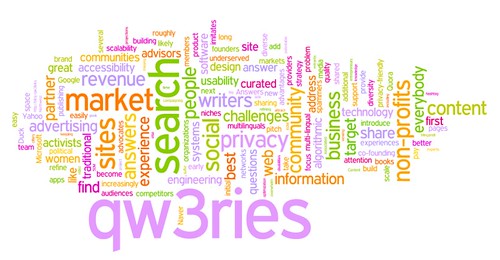qweries helps everybody
find answers
get in the conversation,
and contribute to your community
by prioritizing diversity and design
As I described on the NWEN blog in The agile one-pager (part 5), a good one-line pitch covers what a company does, who they do it for, and a bit about how. Here’s what I’ve currently got for qweries, a Q&A (questions-and-answers) startup that will compete with sites like Quora and Yahoo! Answers.
Reactions?
Suggestions?
Suppose I were to add a third word: “by prioritizing design, _______, and diversity.”  Some of the possibilities that leap to mind include “privacy”, “community”, “emotion”, “accessibility”, “fun” … Thoughts on any of those, or other ideas?
jon
PS: updated several times, most recently May 25. Thanks to everybody who’s given feedback, and especially to Mikhaila for
PPS: For more about qwe ries, here’s the current short overview (most recently updated November 2011). If you can’t get to it via Slideshare links, here’s a PDF version.


 One of the people I asked for feedback on Facebook had some great comments. Here they are (with permission of course):
One of the people I asked for feedback on Facebook had some great comments. Here they are (with permission of course):



Leave a Reply